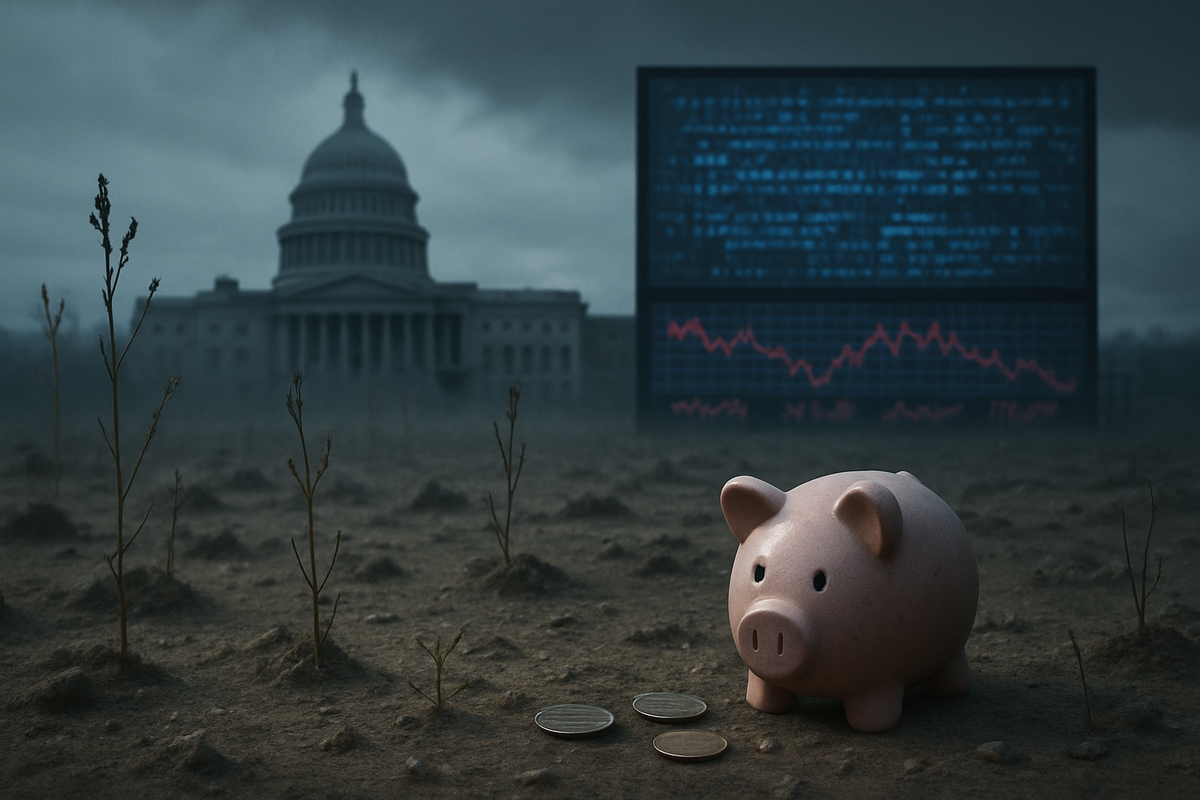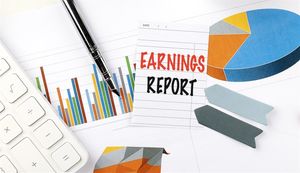
Washington D.C., October 6, 2025 – The American labor market appears to have hit a significant speed bump, with Moody's Analytics reporting "essentially no job growth" for the U.S. in September 2025. This concerning assessment comes at a critical juncture for the economy, compounded by an ongoing federal government shutdown that has indefinitely delayed the release of the official Bureau of Labor Statistics (BLS) employment report. The findings from Moody's Analytics' chief economist, Mark Zandi, paint a picture of a stagnant job market, with what little growth occurred being heavily concentrated in just a handful of states and predominantly within the healthcare sector. This "data blackout" leaves policymakers, particularly the Federal Reserve, "flying blind" as they grapple with crucial decisions regarding interest rates and monetary policy, intensifying fears of an impending economic slowdown or even a recession.
The implications of this stalled job growth are profound and immediate. A healthy labor market is a cornerstone of economic stability, driving consumer spending and overall economic expansion. The absence of broad-based job creation, as suggested by Moody's, signals underlying weakness that could cascade through various sectors, impacting corporate earnings and consumer confidence. With the official September employment figures held hostage by political gridlock, the market is left to parse alternative data, creating an environment of heightened uncertainty and anxiety for investors, businesses, and American households alike.
A Stalled Engine: Moody's Alarming September Job Growth Assessment
Moody's Analytics' chief economist, Mark Zandi, offered a stark assessment for September 2025, indicating that private data sources point to "essentially no job growth" across the United States. This conclusion, derived from an analysis of alternative metrics such as Revelio Labs, which estimated a modest gain of 60,000 jobs, and payroll processor ADP (NASDAQ: ADP), which reported a decrease of 32,000 private-sector jobs, suggests a significant cooling in hiring activity. Zandi had previously anticipated that the economy would add "no jobs in September," a prediction that now appears to be largely affirmed by the available private data. This stagnation represents a critical departure from the robust job creation seen in earlier periods, underscoring a worrying trend for the nation's economic health.
The minimal job growth that did occur in September was notably narrow in scope, almost entirely concentrated within the education and healthcare sectors. Zandi has consistently highlighted the U.S. job market's increasing reliance on these specific industries, noting that without their contributions, overall job growth would effectively grind to a halt. Within healthcare, the gains were predominantly driven by large companies, while smaller businesses, often seen as the engine of job creation, faced greater headwinds, partly attributed to tariffs and restrictive immigration policies. Geographically, the weakness was also pronounced, with Zandi estimating that 22 states, along with the District of Columbia, are experiencing persistent economic weakness and job losses. States with struggling agricultural economies or light manufacturing sectors were particularly hard hit. While large economies like California (NASDAQ: CA) and New York (NYSE: NY) are crucial for broader stability, some states exhibited surprising trends; Georgia (NYSE: GA), for instance, is reportedly in recession due to factors like declining domestic immigration and high home prices, while Pennsylvania (NYSE: PA) is performing relatively well, buoyed by its strong education and healthcare sectors.
The most pressing consequence of these findings and the broader economic climate is the unprecedented delay in the release of the official September 2025 Employment Situation Report by the Bureau of Labor Statistics (BLS). This "data blackout" is a direct result of an ongoing federal government shutdown, leaving policymakers without crucial information. This situation is deemed a "serious problem" for economic policymakers, especially the Federal Reserve, as it severely impedes their ability to make informed decisions regarding interest rates and monetary policy. Economists warn that the U.S. economy is "flying blind" at a critical juncture, with the uncertainty surrounding the labor market potentially exacerbating an already anticipated slowdown in economic growth. The absence of official data amplifies concerns about an "elevated recession risk" of 40% over the next 12 months, a figure that could worsen with a prolonged shutdown leading to mass federal layoffs and "havoc on the financial markets," including higher interest rates and depressed stock prices. Each week of the shutdown is estimated to reduce annualized real Gross Domestic Product (GDP) growth by approximately 0.1%, further contributing to an environment where a sharp slowdown in hiring coincides with rising inflation, raising the specter of "stagflation."
Corporate Fortunes in Flux: Who Wins and Who Loses in a Stagnant Labor Market
The revelation of "essentially no job growth" in September 2025, coupled with the broader economic uncertainty and the "data blackout," is poised to significantly reshuffle the corporate landscape, creating distinct winners and losers across various sectors. Companies that offer essential goods and services or facilitate cost-cutting measures are likely to exhibit greater resilience, while those heavily reliant on discretionary spending or robust economic expansion will undoubtedly face considerable headwinds.
The Consumer Discretionary sector stands to be among the hardest hit. With reduced consumer confidence and diminished purchasing power, demand for non-essential goods and services will likely plummet. Luxury retailers and high-end brands, such as LVMH Moët Hennessy Louis Vuitton (EPA: MC) or Ralph Lauren (NYSE: RL), could see sales decline sharply as consumers prioritize necessities. Similarly, the travel and hospitality industries, represented by giants like Carnival Corporation (NYSE: CCL) and Marriott International (NASDAQ: MAR), will likely experience reduced bookings and leisure travel. Conversely, discount retailers like Walmart (NYSE: WMT), Dollar General (NYSE: DG), and Costco Wholesale (NASDAQ: COST) are well-positioned to benefit as consumers trade down to more affordable options. Auto parts and repair companies, such as AutoZone (NYSE: AZO) and O'Reilly Automotive (NASDAQ: ORLY), may also see increased demand as individuals opt to repair existing vehicles rather than purchase new ones.
The Healthcare sector, despite being the sole area of concentrated job growth, presents a mixed bag. While typically considered recession-resistant due to inelastic demand for medical services, the reported stagnation in overall healthcare job growth is a significant warning. It could imply an easing of labor shortages, efficiency gains through technology, or mounting cost-cutting pressures. Companies providing essential pharmaceuticals and medical devices, like Johnson & Johnson (NYSE: JNJ) or Pfizer (NYSE: PFE), are likely to remain stable. However, healthcare staffing agencies, such as AMN Healthcare (NYSE: AMN), could see demand decline if hiring slows further. Hospitals heavily reliant on elective procedures, like HCA Healthcare (NYSE: HCA), might also face reduced revenues as consumers tighten their belts. Large, diversified healthcare providers and insurers, including UnitedHealth Group (NYSE: UNH) and Elevance Health (NYSE: ELV), are generally more robust to weather these shifts.
In the Technology sector, the outlook is bifurcated. Companies heavily dependent on advertising revenue, such as Meta Platforms (NASDAQ: META) and Alphabet (NASDAQ: GOOGL, NASDAQ: GOOG), could see advertising spending curtailed by businesses reducing marketing budgets. Hardware and consumer electronics firms like Apple (NASDAQ: AAPL) may also face headwinds as consumers delay upgrades. However, providers of mission-critical enterprise software, cybersecurity solutions, and cloud computing infrastructure are likely to prove resilient. Microsoft (NASDAQ: MSFT), with its Office 365 and Azure cloud services, Oracle (NYSE: ORCL), and Salesforce (NYSE: CRM) could maintain strong demand as businesses prioritize efficiency and essential operations. Cybersecurity firms like CrowdStrike (NASDAQ: CRWD) and Palo Alto Networks (NASDAQ: PANW) are also expected to see sustained spending. The Financials sector is highly sensitive to economic conditions. Investment banks and asset managers, such as Goldman Sachs (NYSE: GS) and Morgan Stanley (NYSE: MS), could experience reduced revenue from deal activity and market volatility. Conversely, well-capitalized, diversified large banks like JPMorgan Chase (NYSE: JPM) and Bank of America (NYSE: BAC) are generally better positioned to navigate economic slowdowns, though they might see reduced trading volumes and potentially rising loan delinquencies. The absence of clear government data further complicates decision-making, increasing market volatility and potentially delaying business investment, hiring, and expansion plans across all sectors.
A Looming Economic Crossroads: Wider Significance of Stagnant Growth and Data Blackout
The confluence of Moody's Analytics' report of "essentially no job growth" in September 2025 and the paralyzing federal government shutdown creating a "data blackout" carries profound wider significance, placing the U.S. economy at a critical crossroads. This scenario is not merely a snapshot of a single month but reflects deep-seated trends and poses significant challenges for future policy and market stability.
This period fits into a broader narrative of a softening post-pandemic labor market. After a robust rebound, 2025 saw a noticeable deceleration in job creation, with average monthly nonfarm payroll gains significantly lower than in previous years. Moody's Analytics' earlier reports, including revisions, indicated a "slow hiring, slow firing" environment, where businesses were hesitant to expand payrolls substantially. Factors contributing to this stagnation include declining immigration, which has curtailed labor force growth, and ongoing uncertainty from trade policies and the increasing influence of artificial intelligence on labor demand and supply. Simultaneously, inflation remained a persistent concern, hovering above the Federal Reserve's 2% target. The Fed had already initiated interest rate cuts in September 2025, aiming to stabilize the shaky job market. The current mix of stagnant job growth and elevated inflation creates a difficult balancing act for the Fed, risking a potential return to "stagflation" if not managed carefully.
The ripple effects of stalled job growth are extensive, primarily impacting consumer spending and corporate earnings. Consumer confidence, already showing signs of being "stretched" with rising credit card balances and delinquencies in early 2025, is likely to deteriorate further. This financial strain will inevitably lead to reduced discretionary spending, affecting a wide array of industries. For corporations, the wider economic slowdown and consumer hesitancy will dampen earnings, with companies reliant on consumer demand facing reduced sales. Furthermore, the ongoing government shutdown poses a direct threat to corporate earnings, particularly for businesses with significant exposure to government contracts, as delayed payments could impact cash flow. Regulatory bottlenecks at agencies operating with minimal staff during the shutdown could also slow critical approvals for new drugs, environmental permits, and mergers and acquisitions, impacting sectors like biotech, energy, and financial services.
From a regulatory and policy standpoint, the "data blackout" is perhaps the most critical challenge. The Federal Reserve relies heavily on timely and accurate official economic data, such as the monthly jobs report and the Consumer Price Index, to inform its monetary policy decisions, including interest rate adjustments. With the Bureau of Labor Statistics (BLS) suspending operations and delaying these critical releases, the Fed is effectively "flying blind," making it incredibly difficult to accurately assess the true health of the economy. This lack of comprehensive official data severely compromises the Fed's capacity for timely and appropriate policy decisions, risking missteps that could have long-lasting consequences for financial markets and economic stability. While private sector indicators provide some insight, they cannot fully replace the comprehensive official government data. Historically, government shutdowns, such as the 35-day shutdown in 2018-2019 or the 16-day shutdown in 2013, have consistently resulted in delays of critical economic data, complicating the Fed's policy decisions and often leading to increased market volatility. The current situation, with a potentially precarious economy, suggests that this shutdown could have a more significant and lasting impact than some past instances.
The Road Ahead: Navigating an Uncertain Economic Landscape
The immediate and extended outlook for the U.S. economy is fraught with uncertainty following Moody's Analytics' report of "essentially no job growth" in September 2025, compounded by the ongoing government shutdown that has plunged official economic data into a "blackout." This dual challenge creates a complex and potentially volatile path forward for businesses, policymakers, and investors alike.
In the short term, the absence of crucial official data, including the monthly jobs report, Consumer Price Index (CPI), and Q3 GDP figures, means policymakers, particularly the Federal Reserve, are "flying blind." This severely hampers their ability to make informed interest rate decisions and could lead to policy missteps. Businesses, in turn, are likely to exercise extreme caution in hiring and capital expenditures, prioritizing cost-cutting and operational efficiencies over aggressive expansion. The labor market is expected to remain in a "slow hiring, slow firing" environment, making it more challenging for job seekers. Markets, while showing some "confused, hedged optimism" driven by sectors like AI, also reflect underlying caution with the outperformance of safe-haven assets. However, the true state of consumer financial stress, indicated by falling real wages and rising credit card delinquencies, remains a significant concern.
Looking further ahead, the U.S. economy faces several potential scenarios. A prolonged stagnation is a distinct possibility if the "no job growth" trend persists, trapping the economy in a cycle of low investment, depressed income, and subdued consumer spending. Deloitte (NYSE: DLTE) forecasts U.S. GDP growth to slow to 1.1% in 2025, with job growth potentially turning modestly negative into early 2026. A recession (hard landing) risk is elevated, driven by continued high interest rates, geopolitical disputes, and persistent consumer financial stress. This would entail prolonged stagnation, mass unemployment, and a collapse of consumer demand. The elusive soft landing – where inflation falls without triggering a recession – appears increasingly challenging given the current data vacuum and stagnant job growth. For this to occur, job creation would need to cool but remain positive, allowing wage growth to moderate while employment still increases.
To navigate this treacherous environment, businesses must adopt resilient and agile strategic pivots. This includes strengthening financial planning and risk management through rigorous stress tests and maintaining ample cash reserves. Diversifying revenue streams and markets will be crucial to reduce dependency on single products or customer groups. Enhancing operational flexibility through adaptable employment models and digital transformation for efficiency will also be key. Investing in innovation and R&D to meet evolving market needs and fostering strong customer and employee relationships will be vital for long-term sustainability. Scenario-based planning, where businesses brainstorm different economic outcomes and prepare appropriate actions for each, will enable more effective risk assessment and opportunity identification.
The Path Forward: Resilience and Vigilance in a Shifting Economy
The latest U.S. job growth data, or rather the lack thereof, coupled with the critical government data blackout, signals a period of profound economic uncertainty and calls for heightened vigilance from all stakeholders. Moody's Analytics' finding of "essentially no job growth" in September 2025, concentrated in just a few states and the healthcare sector, underscores a significant cooling in the labor market that could herald a broader economic slowdown or even a recession. The delay of the official employment report due to the federal government shutdown further complicates the picture, leaving policymakers and markets operating in the dark.
The key takeaways from this event are clear: the U.S. labor market is losing momentum, consumer financial health is under strain, and the Federal Reserve's ability to make informed policy decisions is severely compromised. While some sectors, particularly discount retail and essential enterprise technology, may show resilience or even benefit from consumer shifts towards value and efficiency, many others, especially in consumer discretionary and parts of industrials, face significant headwinds. The prolonged absence of reliable government data will continue to fuel market volatility and delay crucial business investment and expansion plans.
Moving forward, the market will be largely driven by the resolution of the government shutdown and the eventual release of the delayed economic data. Investors should watch closely for any signs of an end to the shutdown, as this will provide much-needed clarity on the true state of the economy. Beyond that, the Federal Reserve's subsequent monetary policy decisions will be paramount, as they attempt to balance inflation control with economic stimulation in an environment of ambiguous data. Businesses will need to prioritize financial resilience, operational agility, and strategic diversification to weather potential downturns.
In the coming months, investors should monitor several key indicators: the actual figures from the delayed September employment report, subsequent inflation data, and consumer spending trends. Pay close attention to corporate earnings reports for insights into how companies are adapting to a slower growth environment and managing cost pressures. The performance of defensive sectors and companies with strong balance sheets will likely be a bellwether for market sentiment. The current climate demands a cautious and adaptive investment strategy, focusing on quality and resilience rather than speculative growth. The path ahead is uncertain, but informed decision-making, based on thorough analysis and a keen eye on evolving economic realities, will be crucial for navigating these challenging times.
This content is intended for informational purposes only and is not financial advice.





